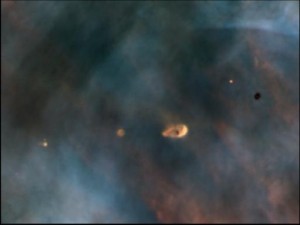Solar System Formation

Credit: Hubble Space Telescope
The Solar System formed from a huge cloud of gas and dust, which collapsed around 4.6 billion years ago. Clouds are usually triggered to collapse. It is thought that the shock wave from a nearby supernova explosion triggered the Solar System cloud to collapse. The cloud would have been very large and several stars, including our Sun, would have formed from it.
After the cores of the new stars were created, any left over material gathered around them. These spinning clouds of gas and dust are known as proto-planetary discs. The material in these discs goes on to form planets.
Planets form by accretion. This is where dust grains in orbit around the star slam into each other to form clumps. The clumps then collide to form larger and larger objects. The size slowly increases as more dust crashes into them over the next few million years.
The inner Solar System was too warm for lighter elements, like gases, to exist. This meant that the planets which formed there were quite small and made of heavy elements like rock and iron. These became the terrestrial planets - Mercury, Venus, Earth and Mars.

disc in a newly forming star system.
Credit: Bill Hartmann
In the outer Solar System it was much cooler, so gases like hydrogen and helium could exist. This meant that large, gas and ice planets could form. These are known today as - Jupiter, Saturn, Uranus and Neptune.
The rest of the material in the disc formed the moons, comets and meteors we see today. The Asteroid Belt, between the planet Mars and Jupiter, contains much of this material. It is thought that a planet was unable to form here because of the strong gravitational pull of Jupiter. Anything left in the disc was blown away by wind from the Sun once it began nuclear fusion.
It is still not known whether all planet systems form in this way, or if the Solar System is unusual.

